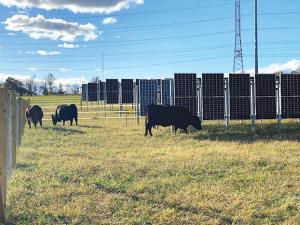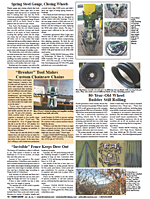Research Trial Monitors Solar And Farm Production
 ✖  |
Rutgers University-New Brunswick is in the early stages of an agrivoltaics research and demonstration project assessing the relationship between solar energy generation and feed and livestock production. The goal is to investigate the potential benefits of solar energy in densely populated areas where land is shared with farming and livestock.
The Rutgers Animal Farm is hosting the initial project effort. There are 378 vertical bifacial solar panels facing east and west along north and south rows. Vertical panels generate electricity whether the sun hits the panel’s front or rear.
A 3-acre grassy field contains three randomized production blocks. Panel rows are spaced at 20 and 40-ft. intervals, with either 2 or 4 ft. ground clearance. Electric wires are hung along the panels to prevent animals from interacting with them while still allowing space for grazing beneath.
“The output from the panels throughout the day is performing as expected,” says Assistant Director and Agrivoltaics Program Lead David Specca. “It’s interesting to see the electrical production curve as the panels catch the eastern morning and western afternoon sun.”
The University selected Sunzaun, a vertical solar system developed by Sunstall Inc., for the Animal Farm portion of the research project.
A small group of beef cows began grazing among the panels in the fall of 2024.
Forage biomass measurements were gathered before and after the cows entered the blocks to determine if the panels impacted production in any way.
“The behavior of the animals is important to us,” Specca says. “Further in the project, the cows will be fitted with GPS devices to monitor their movement and behavior, assessing whether they like the shade from the panels or tend to avoid them.”
This data is hoped to shed light on the potential impact the different spacing and heights have on forage growth, beef performance and behavior.
Electrical power generation data from the panels and their various placements is also being gathered to determine any output differences due to time and season.
“Eventually, we’d like to see if this type of vertical bifacial system will work or affect other crops like vegetables and nursery crops,” Specca says.
Additional University locations in Upper Deerfield and Pittstown, N.J., are completing similar research using single-axis tracker solar panels with pivot points 8 ft. above the ground over staples, vegetable crops and hay.
Several organizations and associations, including the Department of Energy, the N.J. Agricultural Experiment Station, the N.J. Board of Public Utilities, state appropriations, and other federal and state agencies, are funding the 7.4-million-dollar project.
The research trial is expected to continue over three more years.
Contact: FARM SHOW Followup, Rutgers Agrivoltaics Program, New Brunswick, N.J. 08901 (ph 732-330-1573; https://agrivoltaics.rutgers.edu).

Click here to download page story appeared in.
Click here to read entire issue
Research Trial Monitors Solar And Farm Production ENERGY Solar Rutgers University-New Brunswick is in the early stages of an agrivoltaics research and demonstration project assessing the relationship between solar energy generation and feed and livestock production The goal is to investigate the potential benefits of solar energy in densely populated areas where land is shared with farming and livestock The Rutgers Animal Farm is hosting the initial project effort There are 378 vertical bifacial solar panels facing east and west along north and south rows Vertical panels generate electricity whether the sun hits the panel’s front or rear A 3-acre grassy field contains three randomized production blocks Panel rows are spaced at 20 and 40-ft intervals with either 2 or 4 ft ground clearance Electric wires are hung along the panels to prevent animals from interacting with them while still allowing space for grazing beneath “The output from the panels throughout the day is performing as expected ” says Assistant Director and Agrivoltaics Program Lead David Specca “It’s interesting to see the electrical production curve as the panels catch the eastern morning and western afternoon sun ” The University selected Sunzaun a vertical solar system developed by Sunstall Inc for the Animal Farm portion of the research project A small group of beef cows began grazing among the panels in the fall of 2024 Forage biomass measurements were gathered before and after the cows entered the blocks to determine if the panels impacted production in any way “The behavior of the animals is important to us ” Specca says “Further in the project the cows will be fitted with GPS devices to monitor their movement and behavior assessing whether they like the shade from the panels or tend to avoid them ” This data is hoped to shed light on the potential impact the different spacing and heights have on forage growth beef performance and behavior Electrical power generation data from the panels and their various placements is also being gathered to determine any output differences due to time and season “Eventually we’d like to see if this type of vertical bifacial system will work or affect other crops like vegetables and nursery crops ” Specca says Additional University locations in Upper Deerfield and Pittstown N J are completing similar research using single-axis tracker solar panels with pivot points 8 ft above the ground over staples vegetable crops and hay Several organizations and associations including the Department of Energy the N J Agricultural Experiment Station the N J Board of Public Utilities state appropriations and other federal and state agencies are funding the 7 4-million-dollar project The research trial is expected to continue over three more years Contact: FARM SHOW Followup Rutgers Agrivoltaics Program New Brunswick N J 08901 ph 732-330-1573; https://agrivoltaics rutgers edu
To read the rest of this story, download this issue below or click
here to register with your account number.







